Is the following actually possible in SQL?
I have some time-series data and I want to extract some entry and exit points based on prices.
Desired output:
Example Data:
SQL Data:
CREATE TABLE Control
([PKey] int, [TimeStamp] datetime, [Name] varchar(10), [Price1] float, [Price2] float);
INSERT INTO Control ([PKey], [TimeStamp], [Name], [Price1], [Price2])
VALUES
(1,'2018-10-01 09:00:00', 'Name1',120, 125),
(2,'2018-10-01 09:10:00', 'Name1',110, 115),
(3,'2018-10-01 09:20:00', 'Name1',101, 106),
(4,'2018-10-01 09:30:00', 'Name1',105, 110),
(5,'2018-10-01 09:40:00', 'Name1',106, 111),
(6,'2018-10-01 09:50:00', 'Name1',108, 113),
(7,'2018-10-01 10:00:00', 'Name1',110, 115),
(8,'2018-10-01 10:10:00', 'Name1',104, 109),
(9,'2018-10-01 10:20:00', 'Name1',101, 106),
(10,'2018-10-01 10:30:00', 'Name1',99, 104),
(11,'2018-10-01 10:40:00', 'Name1',95, 100),
(12,'2018-10-01 10:50:00', 'Name1',101, 106),
(13,'2018-10-01 11:00:00', 'Name1',102, 107),
(14,'2018-10-01 11:10:00', 'Name1',101, 106),
(15,'2018-10-01 11:20:00', 'Name1',99, 104),
(16,'2018-10-01 11:30:00', 'Name1',105, 110),
(17,'2018-10-01 11:40:00', 'Name1',108, 113),
(18,'2018-10-01 11:50:00', 'Name1',108, 113),
(19,'2018-10-01 12:00:00', 'Name1',109, 114),
(20,'2018-10-01 12:10:00', 'Name1',108, 113),
(21,'2018-10-01 12:20:00', 'Name1',105, 110),
(22,'2018-10-01 12:30:00', 'Name1',101, 106),
(23,'2018-10-01 12:40:00', 'Name1',102, 107),
(24,'2018-10-01 09:00:00', 'Name2',103, 108),
(25,'2018-10-01 09:10:00', 'Name2',101, 106),
(26,'2018-10-01 09:20:00', 'Name2',104, 109),
(27,'2018-10-01 09:30:00', 'Name2',106, 111),
(28,'2018-10-01 09:40:00', 'Name2',108, 113),
(29,'2018-10-01 09:50:00', 'Name2',108, 113),
(30,'2018-10-01 10:00:00', 'Name2',105, 110),
(31,'2018-10-01 10:10:00', 'Name2',103, 108),
(32,'2018-10-01 10:20:00', 'Name2',101, 106),
(33,'2018-10-01 10:30:00', 'Name2',99, 104),
(34,'2018-10-01 10:40:00', 'Name2',101, 106),
(35,'2018-10-01 10:50:00', 'Name2',104, 109),
(36,'2018-10-01 11:00:00', 'Name2',101, 106),
(37,'2018-10-01 11:10:00', 'Name2',99, 104),
(38,'2018-10-01 11:20:00', 'Name2',106, 111),
(39,'2018-10-01 11:30:00', 'Name2',103, 108),
(40,'2018-10-01 11:40:00', 'Name2',105, 110),
(41,'2018-10-01 11:50:00', 'Name2',108, 113),
(42,'2018-10-01 12:00:00', 'Name2',105, 110),
(43,'2018-10-01 12:10:00', 'Name2',104, 109),
(44,'2018-10-01 12:20:00', 'Name2',108, 113),
(45,'2018-10-01 12:30:00', 'Name2',110, 115),
(46,'2018-10-01 12:40:00', 'Name2',105, 110)
;
What have I tried:
I am able to get the first instance of an entry and exit point using the following query which finds the first entry point PKey and then finds the first exit point after the entry point PKey
declare @EntryPrice1 float = 101.0; -- Entry when Price1 <= 101.0 (when not already Entered)
declare @ExitPrice2 float = 113.0; -- Exit when Price2 >= 113.0 (after Entry only)
select
t1.[Name]
,t2.[Entry PKey]
,min(case when t1.[Price2] >= @ExitPrice2 and t1.[PKey] > t2.[Entry PKey] then t1.[PKey] else null end) as [Exit PKey]
from [dbo].[Control] t1
left outer join
(select min(case when [Price1] <= @EntryPrice1 then [PKey] else null end) as [Entry PKey]
,[Name]
from [dbo].[Control]
group by [Name]) t2
on t1.[Name] = t2.[Name]
group by t1.[Name],t2.[Entry PKey]
--Name Entry PKey Exit PKey
--Name1 3 6
--Name2 25 28
I'm stuck on the approach to use that will allow multiple entry/exit points to be returned and not sure if it's even possible in SQL.
The logic for entry an exit points are
Entry - when price1 <= 101.0 and not already in an entry that has not exited.
Exit - when price2 >= 113.0 and inside an entry.


